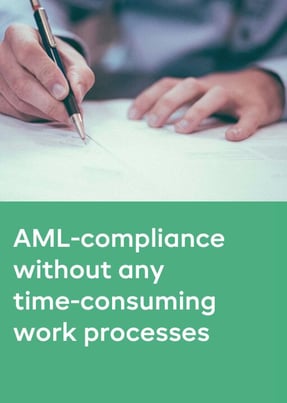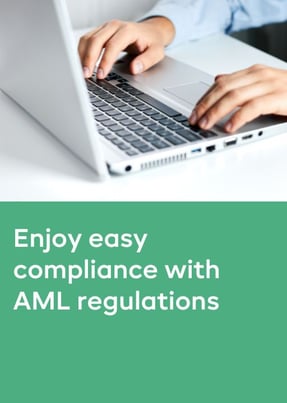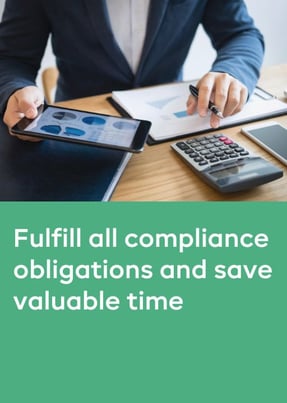- Products
- RegLab for ...
- Knowledge centre
Download the AML glossary >
 Discover the essential AML compliance terminology and gain instant access to a comprehensive guide
Discover the essential AML compliance terminology and gain instant access to a comprehensive guide - The company
Working at RegLab >
Join RegLab as the new Product Owner of our software tool and change the way the legal community approaches anti-money laundering.
There may not be any vacancies that perfectly match your profile, but that does not mean there is no room for someone who can improve RegLab.
- Book a demo
How do you implement your AML procedures in practice?
Question no. 4 from the supervisor
This article builds on the previous discussion about Question No. 3 from the supervisor: “Does your firm have a written risk policy?” In this follow-up, we explore the practical implementation of these procedures. What does this look like in real terms, and what are you expected to demonstrate during an AML audit? This question relates specifically to Article 9 of the AML legislation.
The added value of visualisation
In the previous article, we stressed the importance of drafting a comprehensive risk policy that describes your AML procedures. This policy should outline how your firm handles AML obligations and which steps are taken, and when.
One particularly useful way to bring your policy to life is through visualisation. Written procedures, especially those involving multiple steps and exceptions, are often not easy to follow. Visual aids such as infographics and flowcharts can significantly help employees to think in a process-oriented way. They also serve as practical, user-friendly reference tools at the office.
AML as a chore
Many lawyers we speak to view AML compliance as an administrative burden. It is rarely anyone’s passion project. This leads to a variety of approaches between offices and even within them. Some lawyers take the procedures very seriously and insist on personally overseeing every step, while others delegate significant parts of the process to support staff.
Supervisors take the view that the lawyer is always ultimately responsible for the implementation of the AML policy. Of course, secretarial or support staff can handle certain tasks, such as the initial identification process. However, it remains the lawyer’s responsibility to conduct the final check. This is especially relevant in the context of the four-eyes principle. For example, a secretary may perform ID checks, but assessing whether a transaction is unusual must always be done by the lawyer who understands the matter in depth.
To ensure clarity and legal compliance, your AML procedures must explicitly define roles and responsibilities. Make it clear who is in charge of each step, who reviews what, and who forwards information to whom and at what point. Avoid any ambiguity in responsibilities.
Supervisors also expect to see consistency and uniformity across your firm. The procedures must be applied the same way by everyone. This not only satisfies compliance expectations, but also helps create a streamlined and efficient internal AML process.
To facilitate this, appoint internal specialists. Make their roles visible and clearly defined, and give them the necessary mandate to act. Keep the procedures simple and workable. If they become too complex, they may become unmanageable in practice.
Transparency and internal oversight
Keep the firm’s progress transparent. Make files and their status easily accessible to those who need to review them. This includes tracking which files are missing required documentation. You can manage this using software such as RegLab, but even a simple Excel spreadsheet can be an effective starting point.
Your overview might include:
- How many new clients were added during a given period
- Which solicitor is handling each matter
- What parts of the AML process are still outstanding
Discuss this information regularly during team meetings to ensure ongoing awareness and compliance.
Ongoing review of risk qualification
Remain critical and analytical when it comes to client risk classification. Describe when and how you initiate due diligence, and specify the criteria used to choose between simplified, standard, or enhanced due diligence. Supervisors expect to see these considerations reflected in your procedures.
Writing down policy and procedures
Documenting policy and procedures is not a quick task. There are often many exceptions, and capturing these in detail can be time-consuming. The following practical tips can help streamline the process:
- Form a project group; do not attempt to draft everything on your own
- Identify and assign specific tasks and responsibilities
- Appoint internal AML specialists or ‘super users’ and provide them with appropriate training
- Keep the procedures as practical and centralised as possible
- Visualise the process in diagrams or flowcharts to enhance clarity and usability
- Make sure the core steps are easy for everyone to follow
- For more complex matters, establish clear escalation routes to trained specialists
- Consider engaging an external advisor to help design, document, and implement the procedures in an efficient and effective way
If you prefer not to develop your policy independently, or if you are looking for support in both writing and implementing AML procedures, the team at RegLab is available to assist. We can also support you in designing visual representations of your processes, helping ensure your AML approach is practical, accessible, and auditable.
Themed file: fully prepared for the supervisor’s audit
This article is part of a number of articles and downloads that will help you prepare yourself for the supervisor’s visit. This content is based on a supervisor's FAQs during an audit. Do you want to be 100% AML-proof and ready for the supervisor’s visit? Find all FAQs in our Knowledge Centre.
Knowledge centre
Download the whitepaper: "AML misconceptions"
We list ten myths about money laundering prevention and provide practical tips to improve your process.





